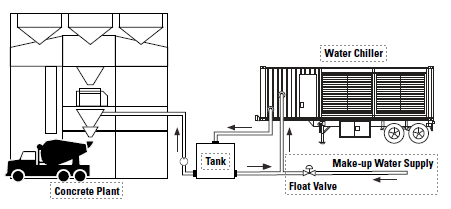Concrete Cooling
Some concrete pours must maintain a precise temperature to achieve the specified strength and characteristics. In these cases, contractors often have to work at night, which increases their labor costs. The transport life of concrete also is a function of temperature, which affects the curing rate. Rental chillers may be at the concrete plant to cool the water used in the mix, and AC units or chillers and AHUs can maintain correct temperatures during the pour to control cure rates.
An example installation at a concrete plant is shown below:
Controlling temperature in concrete mix
Rental equipment that can be used for concrete cooling applications includes the following:
AC units or chiller modules ranging from 25 to 300 tons
Pump modules, circulation tanks, cooling towers, or heat exchanger modules
Ducting, piping, and fittings
Engineering and supervision services
Installation and maintenance services
On-site operation and training
Typical Customers:
Primary customers for concrete cooling applications include concrete mixing plants and contractors. Look for large construction jobs such as high-rise buildings, bridges, dams, stadiums, parking decks, and other facilities that incorporate high-strength concrete.
Discovery Questions:
Do you need to control the temperature of your concrete mixes? If so, what processes do you use?
Have you ever added ice to your concrete mixes to slow curing rates? If so, what does this add to the cost per yard of concrete?
How often have you had to dump a concrete mix because it began to cure before you could get to the pour?
Do you ever need ambient temperatures during concrete pours in order to affect curing rates?
Do you ever have to work nights to take advantage of cooler temperatures? If so, how much does this add to your costs?
Configuration and Installation Issues:
How and where will you tie into the current system? Be sure to locate the chiller upwind from the plant to minimize concrete dust issues.
What is the temperature of make-up water feeding the system? This must be factored into sizing calculations.
What flow rate is required? Concrete customers usually talk about batches per hour or gallons per batch. Make sure both of these factors are included in your calculations.
Since this is a batch operation, the use of chilled water is either on or off. A circulation tank is usually required to prevent operational problems.


